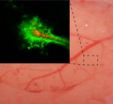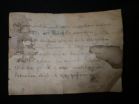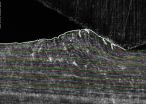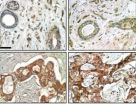(Press-News.org) The brain is a notoriously difficult organ to treat, but Johns Hopkins researchers report they are one step closer to having a drug-delivery system flexible enough to overcome some key challenges posed by brain cancer and perhaps other maladies affecting that organ.
In a report published online on August 29 in Science Translational Medicine, the Johns Hopkins team says its bioengineers have designed nanoparticles that can safely and predictably infiltrate deep into the brain when tested in rodent and human tissue.
"We are pleased to have found a way to prevent drug-embedded particles from sticking to their surroundings so that they can spread once they are in the brain," says Justin Hanes, Ph.D., Lewis J. Ort Professor of Ophthalmology, with secondary appointments in chemical and biomolecular engineering, biomedical engineering, oncology, neurological surgery and environmental health sciences, and director of the Johns Hopkins Center for Nanomedicine.
After surgery to remove a brain tumor, standard treatment protocols include the application of chemotherapy directly to the surgical site to kill any cells left behind that could not be surgically removed. To date, this method of preventing tumor recurrence is only moderately successful, in part, because it is hard to administer a dose of chemotherapy high enough to sufficiently penetrate the tissue to be effective and low enough to be safe for the patient and healthy tissue.
To overcome this dosage challenge, engineers designed nanoparticles – about one-thousandth the diameter of a human hair – that deliver the drug in small, steady quantities over a period of time. Conventional drug-delivery nanoparticles are made by entrapping drug molecules together with microscopic, string-like molecules in a tight ball, which slowly breaks down when it comes in contact with water. According to Charles Eberhart, M.D., a Johns Hopkins pathologist and contributor to this work, these nanoparticles historically have not worked very well because they stick to cells at the application site and tend to not migrate deeper into the tissue.
Elizabeth Nance, a graduate student in chemical and biomolecular engineering at Hopkins, and Hopkins neurosurgeon Graeme Woodworth, M.D., suspected that drug penetration might be improved if drug-delivery nanoparticles interacted minimally with their surroundings. Nance first coated nano-sized plastic beads of various sizes with a clinically tested molecule called PEG, or poly(ethylene glycol), that had been shown by others to protect nanoparticles from the body's defense mechanisms. The team reasoned that a dense layer of PEG might also make the beads more slippery.
The team then injected the coated beads into slices of rodent and human brain tissue. They first labeled the beads with glowing tags that enabled them to see the beads as they moved through the tissue. Compared to non-PEG-coated beads, or beads with a less dense PEG coating, they found that a dense coating of PEG allowed larger beads to penetrate the tissue, even those beads that were nearly twice the size previously thought to be the maximum possible for penetration within the brain. They then tested these beads in live rodent brains and found the same results.
The researchers then took biodegradable nanoparticles carrying the chemotherapy drug paclitaxel and coated them with PEG. As expected, in rat brain tissue, nanoparticles without the PEG coating moved very little, while PEG-covered nanoparticles distributed themselves quite well.
"It's really exciting that we now have particles that can carry five times more drug, release it for three times as long and penetrate farther into the brain than before," says Nance. "The next step is to see if we can slow tumor growth or recurrence in rodents." Woodworth added that the team "also wants to optimize the particles and pair them with drugs to treat other brain diseases, like multiple sclerosis, stroke, traumatic brain injury, Alzheimer's and Parkinson's." Another goal for the team is to be able to administer their nanoparticles intravenously, which is research they have already begun.
INFORMATION:
Authors on the paper include Elizabeth Nance, Graeme Woodworth, Kurt Sailor, Ting-Yu Shih, Qingguo Xu, Ganesh Swaminathan, Dennis Xiang, Charles Eberhart and Justin Hanes, all from The Johns Hopkins University.
This work was supported by grants from the National Cancer Institute (R01CA164789 and U54CA151838).
On the Web:
Link to article in Science Translational Medicine: http://stm.sciencemag.org/content/4/149/149ra119
Hanes lab publications: http://www.hopkinsmedicine.org/kimmel_cancer_center/experts/Laboratory_Scientists/detail/A602624173773B994F71AE88C5BCF392/Justin_Hanes
Hanes' professorship announced at Wilmer Eye Institute: http://www.hopkinsmedicine.org/wilmer/news/hanes_professorship.html
Chemical and Biomolecular Engineering Department: http://www.jhu.edu/chembe/
Improved nanoparticles deliver drugs into brain
2012-09-12
ELSE PRESS RELEASES FROM THIS DATE:
Newly discovered letters and translated German ode expand Texas link to infamous Bone Wars
2012-09-12
In the late 1800s, a flurry of fossil speculation across the American West escalated into a high-profile national feud called the Bone Wars.
Drawn into the spectacle were two scientists from the Lone Star State: geologist Robert T. Hill, now acclaimed as the Father of Texas Geology, and naturalist Jacob Boll, who made many of the state's earliest fossil discoveries.
Hill and Boll had supporting roles in the Bone Wars through their work for one of the feud's antagonists, Edward Drinker Cope. A new study by vertebrate paleontologist Louis L. Jacobs at Southern Methodist ...
Scripps Research scientists devise powerful new method for finding therapeutic antibodies
2012-09-12
LA JOLLA, CA, September 11, 2012 – Scientists at The Scripps Research Institute have found a new technique that should greatly speed the discovery of medically and scientifically useful antibodies, immune system proteins that detect and destroy invaders such as bacteria and viruses. New methods to discover antibodies are important because antibodies make up the fastest growing sector of human therapeutics; it is estimated that by 2014 the top-three selling drugs worldwide will be antibodies.
The new technique, described in an article this week published online ahead of ...
Ageism presents dilemmas for policymakers worldwide
2012-09-12
The negative consequences of age discrimination in many countries are more widespread than discrimination due to race or gender, yet differential treatment based on a person's age is often seen as more acceptable and even desirable, according to the newest edition of the Public Policy & Aging Report (PP&AR). This publication, which features cross-national perspectives, was jointly produced by The Gerontological Society of America (GSA) and AGE UK.
The PP&AR explores how discriminatory behaviors manifest themselves, steps that are being taken to address those behaviors, ...
Sliding metals show fluidlike behavior, new clues to wear
2012-09-12
"We see phenomena normally associated with fluids, not solids," said Srinivasan Chandrasekar, a professor of industrial engineering at Purdue University, working with postdoctoral research associates Narayan Sundaram and Yang Guo.
Numerous mechanical parts, from bearings to engine pistons, undergo such sliding.
"It has been known that little pieces of metal peel off from sliding surfaces," Chandrasekar said. "The conventional view is that this requires many cycles of rubbing, but what we are saying is that when you have surface folding you don't need too many cycles for ...
NASA's Global Hawk investigating Atlantic Tropical Depression 14
2012-09-12
NASA's Hurricane and Severe Storm Sentinel (HS3) airborne mission sent an unmanned Global Hawk aircraft this morning to study newborn Tropical Depression 14 in the central Atlantic Ocean that seems primed for further development. The Global Hawk left NASA's Wallops Flight Facility on Wallops Island, Va., this morning for a planned 26-hour flight to investigate the depression.
NASA's latest hurricane science field campaign began on Sept. 7 when the Global Hawk flew over Hurricane Leslie in the Atlantic Ocean. HS3 marks the first time NASA is flying Global Hawks from the ...
Scrub jays react to their dead
2012-09-12
Western scrub jays summon others to screech over the body of a dead jay, according to new research from the University of California, Davis. The birds' cacophonous "funerals" can last for up to half an hour.
Anecdotal reports have suggested that other animals, including elephants, chimpanzees and birds in the crow family, react to dead of their species, said Teresa Iglesias, the UC Davis graduate student who carried out the work. But few experimental studies have explored this behavior.
The new research by Iglesias and her colleagues appears in the Aug. 27 issue of ...
Protein linked to therapy resistance in breast cancer
2012-09-12
A gene that may possibly belong to an entire new family of oncogenes has been linked by researchers with the U.S. Department of Energy (DOE)'s Lawrence Berkeley National Laboratory (Berkeley Lab) to the resistance of breast cancer to a well-regarded and widely used cancer therapy.
One of the world's leading breast cancer researchers, Mina Bissell, Distinguished Scientist with Berkeley Lab's Life Sciences Division, led a study in which a protein known as FAM83A was linked to resistance to the cancer drugs known as EGFR-TKIs (Epidermal Growth Factor Receptor-Tyrosine Kinase ...
What are the effects of the Great Recession on local governments?
2012-09-12
Freezing positions and cutting workforces
Trimming pension and health care costs and passing them to employees
Lowering service delivery levels, but not imposing many new fees
Using technology to reduce costs where possible
Receiving added pressure but little help from States and the Federal Government
This important new research sheds light on the challenges faced by city and county governments that must provide most basic services. Unlike federal or state governments, these local governments have limited ability to generate revenue and are often mandated to pay for ...
NASA infrared data reveals fading Tropical Storm Leslie and peanut-shaped Michael
2012-09-12
When NASA's Aqua satellite passed over the Atlantic on Sept. 11 it caught Tropical Storm Leslie's clouds over Newfoundland and peanut-shaped Tropical Storm Michael to its southwest. The Atmospheric Infrared Sounder (AIRS) instrument captured infrared data on Tropical Storms Leslie and Michael when it passed overhead on Sept. 11.
Michael Appears Peanut-Shaped on Satellite Imagery
Tropical Storm Michael forecast to become a remnant low later today, Sept. 11, but as of 11 a.m. EDT Michael still had maximum sustained winds near 45 mph (75 kmh). It was located about 1,090 ...
Yellow lights mean drivers have to make right choice -- if they have time
2012-09-12
A couple of years ago, Hesham Rakha misjudged a yellow traffic light and entered an intersection just as the light turned red. A police officer handed him a ticket.
"There are circumstances, as you approach a yellow light, where the decision is easy. If you are close to the intersection, you keep going. If you are far away, you stop. If you are almost at the intersection, you have to keep going because if you try to stop, you could cause a rear-end crash with the vehicle behind you and would be in the middle of the intersection anyway," said Rakha, professor of civil ...








